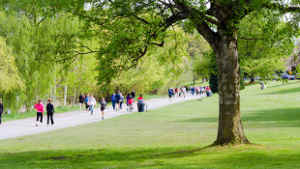Built environment doesn’t play expected role in weight gain

New research suggests fast food and other aspects of built environments don’t affect weight, contrary to earlier findings
People don’t gain or lose weight because they live near a fast-food restaurant or supermarket, according to a new study led by Kaiser Permanente Washington Health Research Institute and the University of Washington. And, living in a more “walkable,” dense neighborhood likely only has a small impact on weight.
Prior research has suggested that living close to a supermarket might lead to lower weight gain or more weight loss, while living close to lots of fast-food restaurants might lead to weight gain. These “built environment” amenities were seen as essential contributors to losing weight or tending toward obesity. The idea appears obvious: If you live next to a fast-food restaurant, you’ll eat there more and thus gain weight. Or, if you have a supermarket nearby, you’ll shop there, eat healthier, and thus lose weight. Live in a neighborhood that makes walking and biking easier and you’ll get out, exercise more, and burn more calories.
“Our analyses of the food environment and density together suggests that the more people there are in an area — higher density — the more supermarkets and fast-food restaurants are located there. And we found that density matters to weight gain, but not proximity to fast food or supermarkets. So, that seems to suggest that those other studies were likely observing a false signal,” said James Buszkiewicz, lead author of the study and a research scientist in the UW School of Public Health.
The study, published earlier this month in the International Journal of Obesity, found that people living in neighborhoods with higher residential and population density weigh less and have less obesity than people living in less-populated areas. And that didn’t change over a 5-year period of study.
The study, based on anonymized medical records from more than 100,000 Kaiser Permanente Washington patients, did not find that living near supermarkets or fast-food restaurants had any impact on weight. However, urban density — such as the number of houses in a given neighborhood, which is closely linked to neighborhood “walkability” — appears to be the strongest element of the built environment linked to change in body weight over time.
On the whole, in terms of ways to curb the obesity epidemic, the study suggests there’s likely no simple fix from the built environment, like putting in a playground or supermarket. Rather than the built environment itself influencing the weight of individuals, community-level differences in obesity are more likely driven by systematic factors — such as income inequality, which is often the determining factor of where people can afford to live and whether they can afford to move. Thus factors that outweigh things in the built environment may include whether one can afford to eat a healthy diet or to have the time to exercise.
The researchers studied Kaiser Permanente Washington records to gather body weight measurements several times over a 5-year period. They also used geocodable addresses to establish neighborhood details, including property values to help establish socioeconomic status, residential unit density, population density, road intersection density, and counts of supermarkets and fast-food restaurants accessible within a short walk or drive.
“This study really leverages the power of big data,” said Dr. David Arterburn, co-author and senior investigator at Kaiser Permanente Washington Health Research Institute. “Our use of anonymized health care records allows us to answer important questions about environmental contributions to obesity that would have been impossible in the past.”
This study is part of a 12-year, joint UW and Kaiser Permanente Washington research project called Moving to Health. The goal of the study, according to the project website, is to provide population-based, comprehensive, rigorous evidence for policymakers, developers, and consumers regarding the features of the built environment that are most strongly associated with risk of obesity and diabetes.
“Our next goal is to better understand what happens when people move their primary residence from one neighborhood to another,” Arterburn said. “When our neighborhood characteristics change rapidly — such as moving to a much more walkable residential area — does that have an important effect on our body weight?”
Co-authors include Jennifer Bobb, Andrea Cook, Maricela Cruz, Paula Lozano, Dori Rosenberg, Mary Kay Theis, and Jane Anau at Kaiser Permanente Washington Health Research Institute; Anne Vernez Moudon, UW Urban Form Lab, College of Built Environments; Stephen Mooney, UW Department of Epidemiology; Philip Hurvitz, UW Urban Form Lab and Center for Studies in Demography and Ecology; and Shilpi Gupta and Adam Drewnowski, UW Center for Public Health Nutrition and Department of Epidemiology. This research manuscript was supported by grants from the National Institutes of Health: 1 R01 DK 114196, 5 R01 DK076608, and 4 R00LM012868.
co-researchers
Jennifer F. Bobb, PhD
Senior Biostatistics Investigator
Kaiser Permanente Washington Health Research Institute
Andrea J. Cook, PhD
Senior Biostatistics Investigator
Kaiser Permanente Washington Health Research Institute
Maricela Cruz, PhD
Associate Biostatistics Investigator
Kaiser Permanente Washington Health Research Institute
Paula Lozano, MD, MPH
Senior Investigator; Director, ACT Center
Kaiser Permanente Washington Health Research Institute
Dori E. Rosenberg, PhD, MPH
Senior Investigator
Kaiser Permanente Washington Health Research Institute
Healthy communities

How should we study the health of neighborhoods?
UW/KPWHRI research team confers with King County organizations at its "Moving to Health" Summit, sparking new collaborations.
Moving to health

How can your neighborhood nudge you toward healthier behavior?
Dr. Arterburn and UW/KPWHRI team go hyperlocal with $2.67-million Moving to Health award from NIDDK on ‘built environment’.



